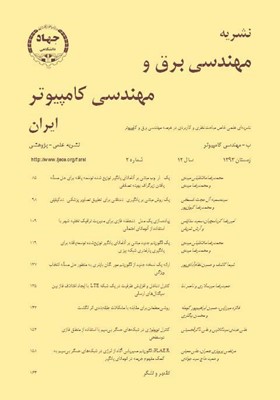کنترل توپولوژی در شبکههای حسگر بیسیم با استفاده از منطق فازی دوسطحی
محورهای موضوعی : مهندسی برق و کامپیوترعلي عبدي سيدکلايي 1 , علي ذاکرالحسيني 2
1 - دانشگاه شهید بهشتی
2 - دانشگاه شهید بهشتی
کلید واژه: خوشهبندی شبکه حسگر بیسیم کنترل توپولوژی منطق فازی,
چکیده مقاله :
شبکههای حسگر بیسیم نسل جدیدی از شبکهها هستند که از حسگرها برای دریافت اطلاعات پیرامون محیط خود استفاده میکنند و ارتباط این حسگرها به طور بیسیم است. یکی از مسایلی که در شبکههای حسگر بیسیم از اهمیت زیادی برخودار میباشد بحث کاهش مصرف انرژی و افزایش طول عمر شبکه است. کنترل توپولوژی یکی از روشهای کاهش مصرف انرژی و افزایش طول عمر شبکه بوده و تاكنون روشهاي مختلف كنترل توپولوژي به منظور کاهش مصرف انرژی و افزایش طول عمر شبکه ارائه شده که از جمله آنها خوشهبندی است و یکی از روشهای معروف خوشهبندی LEACH میباشد. در این مقاله ما سعی داریم یک روش خوشهبندی جدیدی ارائه دهیم که نسبت به LEACH و سایر روشهای بهبودیافته بعد از LEACH برتری داشته باشد. ما در این روش خوشهبندی از منطق فازی دوسطحی استفاده میکنیم که باعث کاهش مصرف انرژی و افزایش عمر شبکه در مقایسه با روشهای دیگر میشود و برای اثبات برتری روشمان در مقایسه با روشهای دیگر، مقایسهای با استفاده از نرمافزار MATLAB ارائه دادهایم.
Wireless sensor networks are a new generation of networks that from sensors uses to get information about itself environment and communication this sensors is as wireless. One of the issues that is very important in wireless sensor networks is Discussion reducing energy consumption and increasing network lifetime. Topology control is one of the methods to reduce energy consumption and increase the lifetime of the network. Since different methods of topology control, to reduce energy consumption and enhance the network lifetime is proposed that including them is the clustering and one of the most famous clustering methods is LEACH. In this paper, we try to present a new clustering method that is superior compared to leach and other improved methods after the LEACH. we use in our clustering method from two-level fuzzy logic that be causing reduce energy consumption and increase the network lifetime compared to other methods and to prove the superiority of our method compared with other methods, we present a comparison using MATLAB software.
[1] A. K. Singh, N. Purohit, K. P. Singh, and M. Shukla, "A novel approach for lifetime analysis of sensor network using fuzzy logic," in Proc. of India Conf., INDICON, 6 pp., Dec. 2011.
[2] W. Heinzelman, A. Chandrakasan, and H. Balakrishnan, "Energy - efficient communication protocol for wireless microsensor networks," in Proc. of 33rd Hawaii Int. Conf. on System Sciences, HICSS'00, vol. 2, pp. 3005-3014, 4-7 Jan. 2000.
[3] Y. M. Tashtoush and M. A. Okour, "Fuzzy self-clustering for wireless sensor networks," in Proc. IEEE/IFIP Int. Conf. on Embedded and Ubiquitous Computing, vol. 1, pp. 223-229, 17-20 Dec. 2008.
[4] J. Zhang, Y. Lin, C. Zhou, and J. Ouyang, "Optimal model for energy - efficient clustering in wireless sensor networks using global simulated annealing genetic algorithm," in Proc. Symp. on Intelligent Information Technology Application Workshops, pp. 656-660, 21-22 Dec. 2008.
[5] R. Taimourei Yenesary and E. Saeedian, "CORDF: cluster heads optimum choice and route discovery in multi-hop connection by using fuzzy logic in wireless sensor networks," American J. of Scientific Research, vol. 64, no. 1, pp. 84-90, Jun. 2012.
[6] Y. Faheem, S. Boudjit, and K. Chen, "Dynamic sink location update scope control mechanism for mobile sink wireless sensor network," in Proc. Int. Conf. on Wireless on Demand Network Systems and Services, pp. 171-178, 26-28 Jan. 2011.
[7] W. B. Heinzelman, A. P. Chandrakasan, and H. Balakrishnan, "An application-specific protocol architecture for wireless microsensor networks," IEEE Trans. on Wireless Communications, vol. 1, no. 4, pp. 660-670, Oct. 2002.
[8] H. Ando, L. Barolli, A. Durresi, F. Xhafa, and A. Koyama, "An intelligent fuzzy - based cluster head selection system for WSNs and its performance evaluation for D3N parameter," in Proc. 2010 Int. Conf. on Broadband, Wireless Computing, Communication and Applications, pp. 648-653, 4-6 Nov.. 2010.
[9] K. N. Veena and B. P. Vijaya Kumar, "Dynamic clustering for wireless sensor networks: a neuro - fuzzy technique approach," in Proc. IEEE Int. Conf. Computational Intelligence and Computing Research, ICCIC'10, 6 pp., 28-29 Dec. 2010.
[10] K. Soharabi and J. Pottie, "Protocols for self-organization of a wireless sensor network," IEEE J. on Personal Commun., vol. 7, no. 5, pp. 16-27, Oct. 2000.
[11] F. Ye, A. Chen, S. Liu, and L. Zhang, "A scalable solution to minimum cost forwarding in large sensor networks," in Proc. 10th Int. Conf. Computer Commun. Networks, ICCCN'01, pp. 304-309, 15-17 Oct. 2001.
[12] S. Lindsey and C. Raghavendra, "PEGASIS: power efficient gathering in sensor information systems," in Proc. IEEE. Aerospace Conference Conf., vol. 3, pp. 1125-1130, 2002.
[13] N. Abazari Torghabeh, M. R. Akbarzadeh, and M. H. Yaghmaee, "Mobile base station management using fuzzy logic in wireless sensor networks," in Proc. 2nd Int. Conf. on Computer Engineering and Technology, vol. 2, pp. 352-356, 16-18 Apr. 2010.
[14] A. Alkesh, A. Kumar Singh, and N. Purohit, "A moving base station strategy using fuzzy logic for lifetime enhancement in wireless sensor network," in the Proc. of IEEE Int. Conf. on Communication Systems and Network Technologies, pp. 198-202, 3-5 Jun. 2011.
[15] A. Vijayalakshmi, K. Arthi, and P. Vanaja Ranjan, "Network lifetime enhancement in wireless sensor networks using fuzzy logic based clustering algorithm," International J. of Soft Computing, vol. 8, no. 5, pp. 321-326, 2013.
[16] A. K. Singh and N. Purohit, "An optimised fuzzy clustering for wireless sensor networks," International J. of Electronics, vol. 101, no. 8, pp. 1027-1041, 4 Jul. 2013.
[17] M. Gharghi, E. Parvinnia, and R. Khayami, "Designing a fuzzy rule base system to head cluster election in wireless sensor networks," Indian J. of Science and Technology, vol. 6, no. 5, pp. 4410-4415, May 2013.


